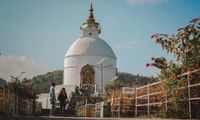Phewa Lake
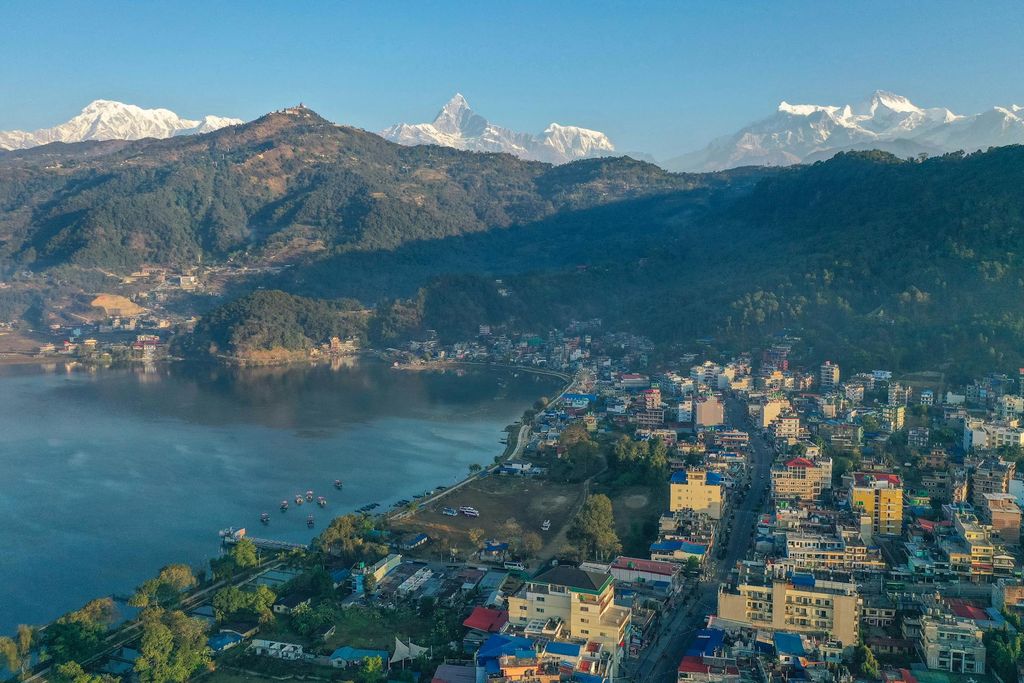
About
Phewa Lake (also known as Fewa Tal) is a breathtaking freshwater lake located in Pokhara, the tourism capital of Nepal. Surrounded by lush green hills and the towering peaks of the Annapurna and Machhapuchhre (Fishtail) mountains, it is the second-largest lake in Nepal and one of the most visited natural attractions in the country.
The lake’s calm blue waters reflect the snow-capped Himalayas, creating one of the most iconic and photographed views in Nepal. At its center lies the beautiful Tal Barahi Temple, a two-story pagoda dedicated to Goddess Barahi — adding a touch of spiritual charm to its scenic landscape.
Phewa Lake is also the lifeline of Pokhara’s tourism and economy, offering activities like boating, kayaking, paragliding, and cycling, while the vibrant Lakeside area around its shore is filled with cozy cafes, restaurants, and shops. The lake supports local livelihoods through tourism, fishing, and irrigation, making it an essential part of both the natural and cultural fabric of Pokhara.
Locate Us
Phewa Lake, also known as Fewa Tal, is the heart and soul of Pokhara, Nepal’s most popular tourist city. Surrounded by lush green hills and overlooked by the majestic Annapurna and Machhapuchhre (Fishtail) mountains, the lake offers a perfect blend of natural beauty and serenity. It is the second-largest lake in Nepal and a centerpiece of Pokhara’s charm, attracting both domestic and international travelers throughout the year.
The calm blue waters of Phewa Lake mirror the snow-capped peaks above, creating one of the most breathtaking views in the Himalayas. At its center lies the Tal Barahi Temple, a sacred Hindu shrine that adds spiritual significance to its scenic landscape. Whether you’re enjoying a peaceful boat ride, watching the sunset from Lakeside, or exploring the vibrant streets nearby, Phewa Lake provides an unforgettable experience that captures the essence of Nepal’s natural and cultural beauty.
Geography and Features
Phewa Lake is located in the Kaski District of Gandaki Province, in the beautiful city of Pokhara, about 200 kilometers west of Kathmandu. Sitting at an altitude of approximately 742 meters (2,434 feet) above sea level, it covers an area of about 4.43 square kilometers, making it the second-largest lake in Nepal after Rara Lake.
The lake is surrounded by rolling green hills, dense forests, and charming Gurung and Magar villages. A picture-perfect scene that attracts photographers and wildlife enthusiasts from all over the world is created when the serene waters on clear days mirror the majestic Annapurna and Machhapuchhre (Fishtail) peaks.
The Tal Barahi Temple, a modest but revered two-story pagoda devoted to Goddess Barahi, is located in the middle of Phewa Lake. The lake's mysterious atmosphere is enhanced by the fact that the shrine is only accessible by boat. The vibrant Lakeside neighborhood, which is surrounded by the shoreline, is well-known for its vibrant boats, cafes, dining options, and laid-back vibe. It strikes the ideal mix of rustic charm and technological economy.
Activities and Attractions
Phewa Lake offers a perfect blend of adventure, relaxation, and cultural exploration. Whether you seek peaceful moments on the water or thrilling outdoor experiences, the lake and its surroundings have something for everyone.
1. Boating and Kayaking
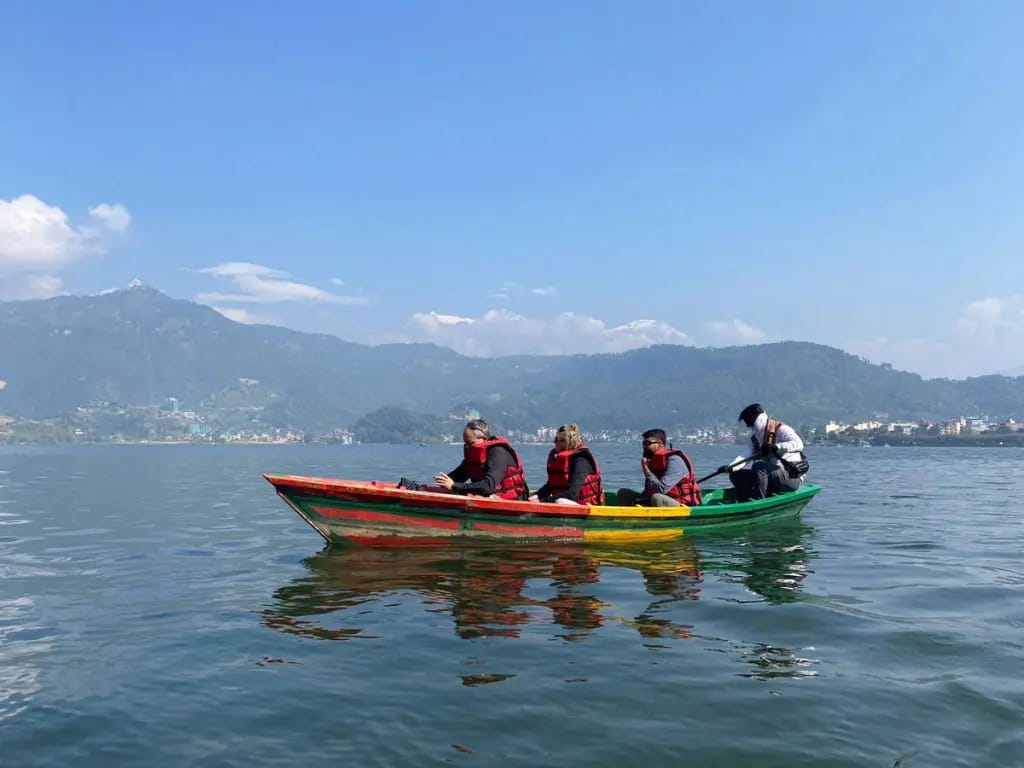
The most popular activity on Phewa Lake is boating. Visitors can rent colorful wooden boats, locally known as “doongas”, to paddle across the calm waters. From short rides to the Tal Barahi Temple to longer trips exploring the lake’s far edges, boating provides a peaceful way to enjoy the lake’s serene beauty. Kayaking is also available for those who prefer a more active experience.
2. Tal Barahi Temple
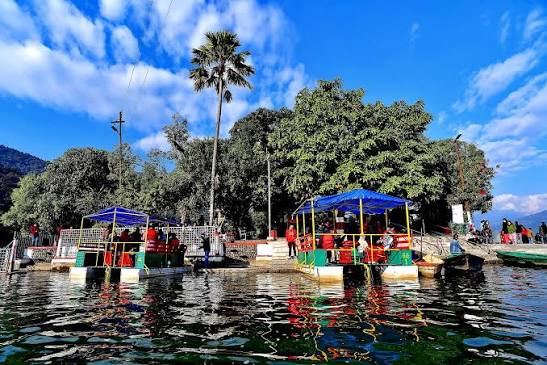
Located on a small island in the middle of the lake, Tal Barahi Temple is one of Pokhara’s most iconic landmarks. Dedicated to Goddess Barahi, this two-tiered pagoda-style temple holds deep spiritual significance. Pilgrims and tourists alike take boats to the temple to offer prayers or simply admire its tranquil surroundings.
3. Lakeside Promenade
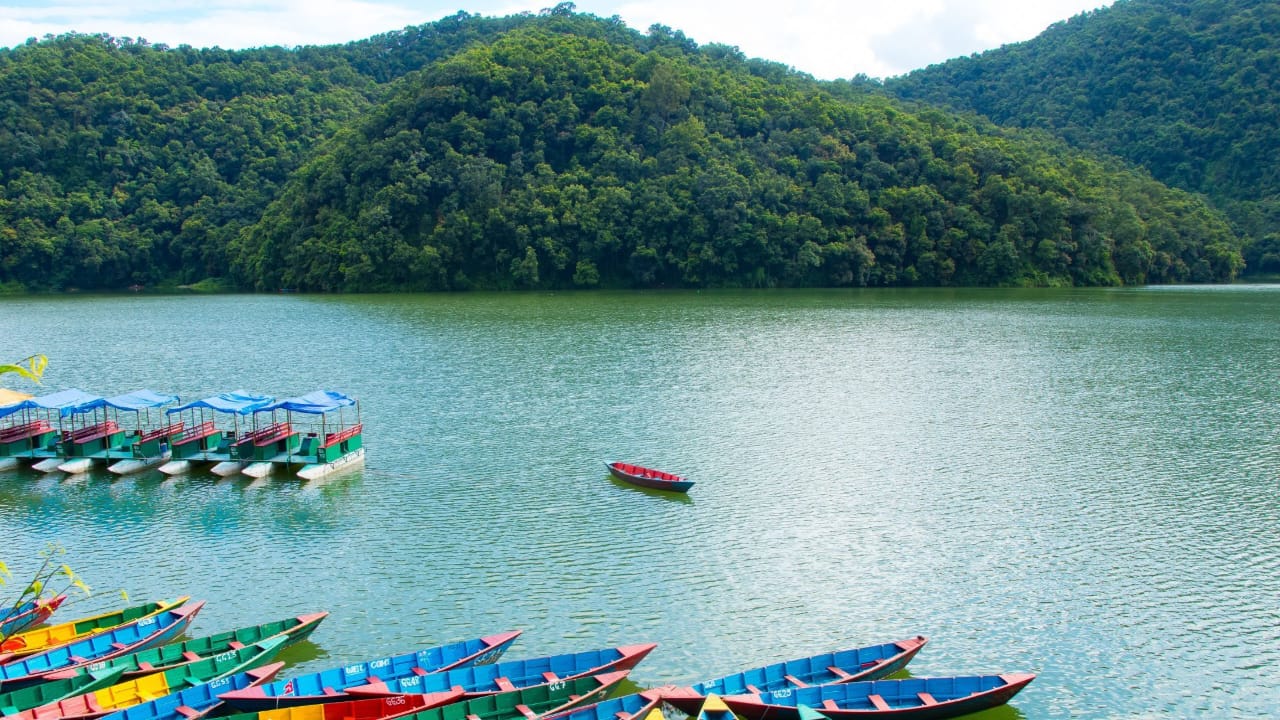
The Lakeside area along Phewa’s eastern shore is a vibrant hub filled with restaurants, cafes, souvenir shops, and guesthouses. Visitors can relax by the water, enjoy local or international cuisine, and watch the stunning sunsets over the lake. The area comes alive in the evening with live music, lights, and a lively yet laid-back atmosphere.
4. Adventure Activities Nearby
For adventure seekers, Phewa Lake’s surroundings offer thrilling experiences such as paragliding from Sarangkot, cycling around the lake, or hiking up to the World Peace Pagoda (Shanti Stupa). Each activity rewards visitors with breathtaking panoramic views of the lake and the snow-capped Himalayas.
5. Photography and Birdwatching
Phewa Lake is a paradise for photographers and nature enthusiasts. The early morning reflections of Machhapuchhre on the water are mesmerizing. The lake area also hosts various species of migratory and local birds, making it an ideal spot for quiet observation and photography.
Phewa Lake is very culturally and spiritually significant to the people of Pokhara and Nepal in general, in addition to its natural beauty. The lake is a living representation of harmony between tradition, faith, and environment, not just a beautiful place to visit.
At the heart of the lake stands the Tal Barahi Temple, a sacred Hindu shrine dedicated to Goddess Barahi, an incarnation of the goddess Durga. According to local beliefs, Barahi is the protector of Pokhara and the surrounding valley. The temple’s location in the middle of the water represents purity, balance, and spiritual power. Devotees visit the temple by boat to offer prayers, especially on Saturdays and during major Hindu festivals like Dashain and Teej.
Phewa Lake also reflects the deep connection between the Himalayan landscape and local spirituality. The surrounding mountains — particularly Machhapuchhre (Fishtail) — are regarded as sacred and are never climbed, out of respect for their divine significance. The calm waters of Phewa are believed to mirror the gods’ presence, and many locals consider the lake a place of peace and blessing.
Tourism and Economy
Phewa Lake serves as the economic and tourism backbone of Pokhara, attracting thousands of visitors every year. Its breathtaking scenery, peaceful atmosphere, and adventure opportunities make it one of the most visited destinations in Nepal, contributing significantly to both the local and national economy.
The tourism industry around Phewa Lake supports a wide range of businesses — from hotels, restaurants, and cafés to souvenir shops, tour operators, and boating services. The Lakeside area has become a bustling hub of activity, where travelers can enjoy everything from budget-friendly stays to luxury resorts, all while being just steps away from the lake’s calm waters.
Boating, paragliding, and sightseeing tours generate steady income for local entrepreneurs, while fishermen and farmers benefit from the lake’s natural resources. Many residents of Pokhara depend directly or indirectly on tourism for their livelihoods.
In recent years, efforts have been made to promote sustainable tourism around Phewa Lake. Local authorities and environmental groups have launched cleanup programs and awareness campaigns to protect the lake from pollution and preserve its natural beauty for future generations.
Environmental Concerns
While Phewa Lake remains one of Nepal’s most stunning natural attractions, it faces several environmental challenges due to rapid urbanization and increasing tourism. Over the past few decades, human activities around the lake have begun to affect its water quality, ecosystem, and natural balance.
One of the major issues is water pollution. Wastewater discharge, plastic litter, and agricultural runoff from nearby settlements have introduced pollutants into the lake. The growing number of hotels and restaurants around the Lakeside area has also contributed to waste accumulation, threatening aquatic life and reducing water clarity.
Another concern is sedimentation. Soil erosion from the surrounding hills, especially during the monsoon season, causes sediments to flow into the lake. This not only decreases its depth but also reduces its overall surface area. If left unchecked, sedimentation could significantly alter the lake’s natural beauty and biodiversity.
The rise in unregulated construction and tourism infrastructure has further put pressure on the lake’s ecosystem. Encroachment along the shoreline has disrupted natural drainage and habitat areas for fish and birds.
Best Time to Visit Phewa Lake
Phewa Lake is a year-round destination, but the best time to visit depends on what kind of experience you’re looking for. The weather and scenery change beautifully with the seasons, offering unique views and activities throughout the year.
1. Autumn (September to November)
Autumn is considered the best season to visit Phewa Lake. The skies are clear, temperatures are pleasant, and the reflection of the Annapurna and Machhapuchhre mountains on the lake is breathtaking. This is also peak trekking season in Nepal, so the city of Pokhara feels lively and full of travelers.
2. Spring (March to May)
Spring brings warm weather, blooming flowers, and a vibrant atmosphere around the lake. The surrounding hills are covered with rhododendrons and greenery, making it a perfect time for boating, hiking, and photography.
3. Winter (December to February)
During winter, mornings are cool and misty, while afternoons are sunny and clear. The visibility of the mountains is often at its best, offering crystal-clear reflections on the calm lake. It’s a great time for those who prefer fewer crowds and peaceful surroundings.
4. Monsoon (June to August)
Monsoon season brings heavy rain, which enhances the greenery around Phewa Lake but can limit outdoor activities. However, the lush landscapes and dramatic clouds create a magical and serene atmosphere for photographers and nature lovers who don’t mind occasional rain.
How to Reach Phewa Lake
Phewa Lake is located in Pokhara, about 200 kilometers west of Kathmandu, and is easily accessible by air or road. Getting there is part of the adventure, offering scenic journeys through Nepal’s beautiful landscapes.
1. By Air
The quickest way to reach Phewa Lake is by taking a domestic flight from Kathmandu to Pokhara. The flight takes around 25–30 minutes and offers spectacular aerial views of the Himalayas. From Pokhara International Airport, it’s just a 10–15 minute drive to the Lakeside area, where Phewa Lake is located.
2. By Road
Traveling by road from Kathmandu to Pokhara is a popular and scenic option. The journey takes about 6–8 hours, depending on traffic and weather conditions. Regular tourist buses, private vehicles, and microbuses operate daily along the Prithvi Highway, passing through lush hills, rivers, and traditional villages along the way.
3. Within Pokhara
Once you’re in Pokhara, reaching Phewa Lake is simple. The Lakeside area is within walking distance from most hotels and guesthouses in the city. You can also hire a taxi, rickshaw, or rent a bicycle to explore the lakeside and nearby attractions at your own pace.
Nearby Attractions
Phewa Lake lies at the heart of Pokhara, surrounded by numerous natural, cultural, and adventure-filled attractions. Visitors can easily explore several must-see sites located just a short distance from the lake. From spiritual landmarks to scenic viewpoints and cultural hubs, each attraction adds a new dimension to the beauty of Pokhara.
1. Tal Barahi Temple
Situated on a small island in the middle of Phewa Lake, Tal Barahi Temple is the lake’s most iconic landmark. Dedicated to Goddess Barahi, this two-tiered pagoda temple is accessible only by boat and offers both spiritual peace and stunning lake views.
2. .jpeg)
Perched on a hilltop overlooking Phewa Lake, the World Peace Pagoda offers one of the best panoramic views of Pokhara city, the Annapurna range, and the shimmering lake below. A short hike or drive leads visitors to this tranquil Buddhist monument built to promote peace and harmony.
3. Davis Falls (Patale Chhango)
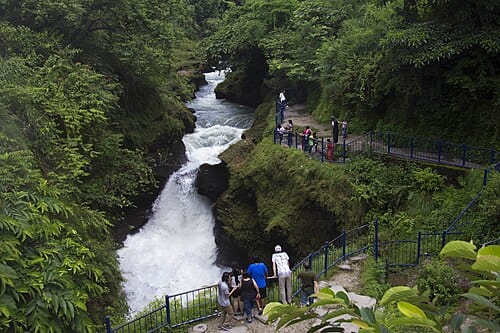
Located a few kilometers southwest of the lake, Davis Falls is a fascinating waterfall where the water from Phewa Lake disappears into an underground tunnel. It’s a unique natural wonder and a popular stop for sightseeing.
4. Gupteshwor Mahadev Cave
Just across from Davis Falls lies the Gupteshwor Mahadev Cave, a sacred Hindu site dedicated to Lord Shiva. Visitors can explore the cave’s winding passages and see the underground waterfall that flows from Davis Falls above.
5. Sarangkot Viewpoint
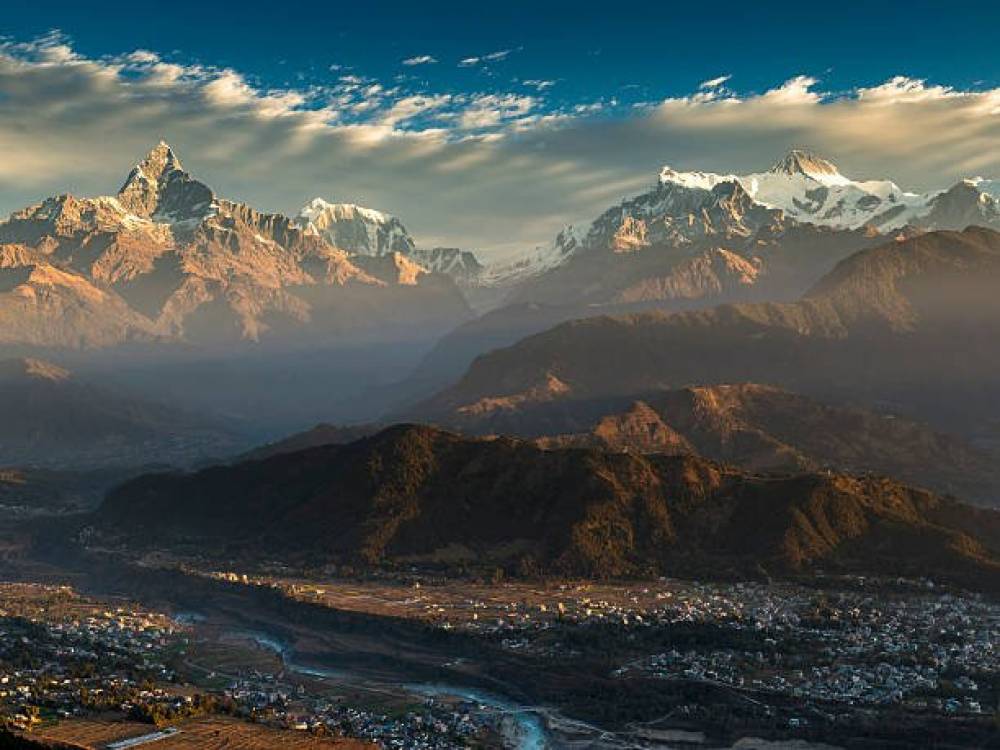
For breathtaking sunrise and sunset views, Sarangkot is a must-visit. Located on a hill north of Phewa Lake, it offers spectacular vistas of the Annapurna and Dhaulagiri ranges. It’s also one of Nepal’s most famous paragliding takeoff points, giving visitors a thrilling way to see the lake from above.
6. Lakeside Area
The vibrant Lakeside neighborhood is the cultural and social hub of Pokhara. With its charming cafes, shops, and live music venues, it’s the perfect place to relax after exploring the natural beauty around the lake.
7. Pumdikot Viewpoint and Shiva Statue
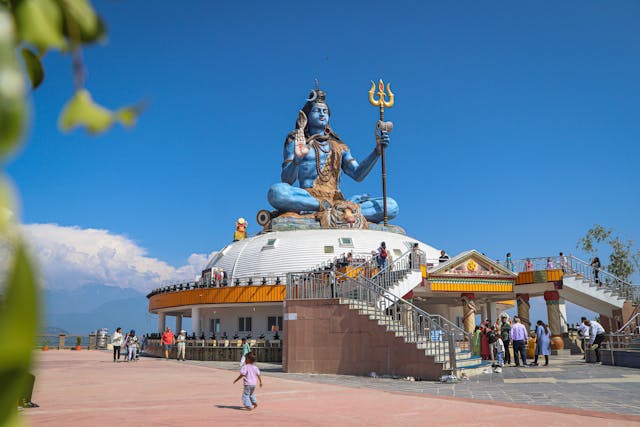
Just a few kilometers uphill from World Peace Pagoda lies Pumdikot Viewpoint, home to one of Nepal’s tallest statues of Lord Shiva. The site offers sweeping panoramic views of Pokhara city, Phewa Lake, and the surrounding Himalayan peaks. The massive Shiva statue, standing gracefully at the hilltop, adds spiritual depth to the area and has become a rapidly growing pilgrimage and tourist destination. The viewpoint is easily accessible by road and makes a perfect combination with a visit to the Peace Pagoda.
8. International Mountain Museum
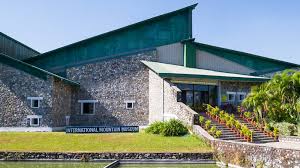
A short drive from Phewa Lake takes you to the International Mountain Museum, which showcases Nepal’s rich mountaineering history and Himalayan culture. The museum features exhibits about famous peaks, legendary climbers, and the traditions of mountain communities. It’s an educational and inspiring place for anyone interested in the world’s highest mountains and the people who call them home.
7. Bindhyabasini Temple
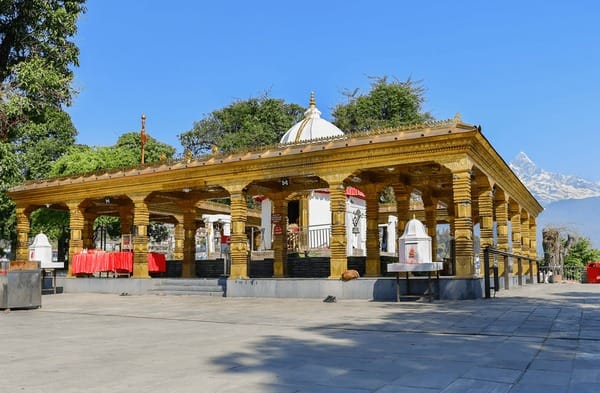
Located on a hill in northern Pokhara, Bindhyabasini Temple is one of the city’s oldest and most sacred Hindu temples. Dedicated to Goddess Bhagwati (a form of Durga), the temple attracts devotees year-round, especially during major Hindu festivals. The hilltop location provides serene views of Pokhara city and the surrounding hills, making it both a spiritual and scenic site.
Conclusion
Phewa Lake is more than just a body of water; it is the heart of Pokhara and a reflection of Nepal’s natural, cultural, and spiritual beauty. Surrounded by majestic mountains, peaceful temples, and a lively lakeside atmosphere, it captures the perfect balance between tranquility and adventure.
From serene boat rides to thrilling paragliding experiences, from quiet temple visits to vibrant evenings by the shore, Phewa Lake offers something special for every traveler. Its calm waters mirror not only the snow-capped peaks above but also the spirit of harmony that defines Nepal.
As one of the country’s most cherished destinations, Phewa Lake continues to inspire awe and wonder among all who visit. Whether you’re seeking peace, photography, culture, or exploration, this lake promises an unforgettable experience, one that stays in your heart long after you’ve left its shores.
FAQs about Phewa Lake, Pokhara – Things to Know Before You Visit
1. Where is Phewa Lake located?
Phewa Lake is located in Pokhara Valley, in the Kaski District of central Nepal. It sits at an elevation of about 742 meters and is the second-largest lake in Nepal. The lake is easily accessible from Pokhara Lakeside, the main tourist hub.
2. What are the best attractions near Phewa Lake, Pokhara?
Some of the top attractions near Phewa Lake include Tal Barahi Temple, World Peace Pagoda, Davis Falls, Gupteshwor Mahadev Cave, Sarangkot Viewpoint, Pumdikot Shiva Statue, Bindhyabasini Temple, International Mountain Museum, and the vibrant Lakeside area.
3. How can I reach Phewa Lake from Pokhara city center or airport?
Phewa Lake is only a 10–15 minute drive from Pokhara Airport or the city’s bus station. Visitors can easily reach the lake by taxi, bicycle, or on foot if staying in the Lakeside area. It’s one of the most accessible and scenic places in Pokhara.
4. Can I do boating in Phewa Lake?
Yes, boating is the most popular activity at Phewa Lake. Visitors can rent wooden boats, pedal boats, or rowboats for a peaceful ride across the lake. You can also visit Tal Barahi Temple, located on an island in the middle of the lake, during your boating trip.
5. What is the best time to visit Phewa Lake?
The best time to visit Phewa Lake is from September to November and March to May, when the weather is clear, and you can enjoy stunning reflections of the Annapurna Himalayas on the lake’s surface. Early morning and evening are the most scenic times of the day.
6. Is swimming allowed in Phewa Lake?
Swimming is not officially encouraged due to varying depths and occasional motorboat traffic. However, locals sometimes swim near the shallower areas. It’s best to enjoy the lake through boating or kayaking for safety.
7. How far is the World Peace Pagoda from Phewa Lake?
The World Peace Pagoda (Shanti Stupa) lies just 2–3 kilometers from the southern shore of Phewa Lake. You can reach it by a short boat ride across the lake followed by a 30–45-minute hike uphill, or by a scenic road drive from Pokhara city.
8. What makes Phewa Lake special?
Phewa Lake is special because it reflects the majestic Annapurna and Machhapuchhre (Fishtail) mountains on its calm waters. It’s also home to the island temple of Goddess Barahi, offering a mix of natural beauty, cultural significance, and spiritual peace — all in one place.
9. Are there good places to eat or stay near Phewa Lake?
Absolutely! The Lakeside area is filled with lakeside cafés, Nepali and international restaurants, boutique hotels, and resorts. Many accommodations offer lake-view rooms and are within walking distance of major attractions.
10. What are some adventure activities near Phewa Lake?
Adventure lovers can try paragliding from Sarangkot, cycling around the lake, zip-lining, boating, kayaking, and short hikes to the Peace Pagoda or Pumdikot viewpoint. These activities make Pokhara one of Nepal’s top adventure destinations.
11. Is Phewa Lake worth visiting at night?
Yes! The night view of Phewa Lake is magical, especially when Lakeside’s lights reflect on the calm water. You can enjoy live music, romantic dinners, or simply relax by the lakeshore and soak in the peaceful ambiance.
12. How many days should I spend in Pokhara to explore Phewa Lake and nearby attractions?
To fully enjoy Phewa Lake and nearby attractions like Sarangkot, Davis Falls, Gupteshwor Cave, and the Peace Pagoda, plan to stay at least 2–3 days in Pokhara. Adventure seekers or photographers may want to extend their stay to 4–5 days.
